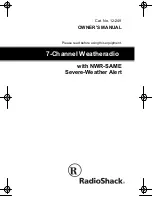
For best results, do not to add more than 32ft of extension cable from item to
item onto the existing cable lengths as this may reduce reception levels.
Again, reception and interference levels will greatly depend on the surrounding
environment at your point of mounting.
19.
Problems and interference with operation
Problem & cause
Remedy
Distance between
transmitters and receiver
too long.
Reduce distance between transmitters and
receiver to receive signal
High shielding materials
between the units (thick
walls, steel, concrete,
isolating aluminum foil
and etc.)
Find a different location for sensors and/or
receiver. See also Item ‘
Transmission
Range’
below.
Interference from other
sources (e.g. wireless
radio, headset, speaker,
etc. operating on the same
frequency)
Find a different location for the sensors
and/or base station. Neighbors using
electrical devices operating on the 433MHz
signal frequency can also cause
interference with reception
No Reception after adding
extension cables
Find a new location for the sensors and/or
base station. Recommend not adding more
than 32ft extension cables between units to
the existing cable lengths, as this will
increase the chance of data reception
problems.
Reception then no
reception - loss of
transmission signal from
the sensor to the base
station
Press and hold the PLUS (+) key for 2
seconds to synchronize the base station to
the sensors for weather data reception. If
still no signal, then change the sensor
batteries and synchronize the units again.
Poor contrast LCD or no
reception or low batteries
in sensors or receiver.
Check the LCD contrast setting or change
batteries (check low battery indicator on the
LCD)
Note:
It is important to keep all the connected extension heads away from rain,
moisture and other extreme weather conditions as exposure can cause short
circuits and damage to this item.
18. Changing
batteries:
Battery change only in the thermo-hygro-sensor:
1.
Open the battery cover
2.
Remove the old batteries and insert with new ones of the recommended
type and replace the cover
Once the sensor is powered up, press and hold the PLUS (+) key for approx. 2
seconds in the normal display mode, the base station will sound a short beep
and synchronize to the sensor otherwise no weather data will be received.
Battery change only in the base station:
1.
Connect power adaptor to base station and power outlet.
2.
Open the battery cover located at the back of the base station.
3.
Remove the old batteries, insert with new ones of the recommended type
and replace the cover
This method of battery replacement will result in no loss of MIN/MAX and
history data. However in case of possible power failure, the base station will
lose the MIX/MAX and all weather data recordings and will need to be
synchronized to the sensors again by pressing the PLUS (+) key for 2
seconds.
Note:
When batteries require replacement for the base station, the low battery
indicator will light up on the LCD.
Quite frequently interferences are only of a temporary nature and may be
easily overcome. If there are wireless headsets, remote babysitters or other
devices working on 433MHz in your house or in the vicinity, their switch-on
time is mostly limited. Furthermore most of these devices allow the change to
an interference-free frequency. Such measures will effectively overcome
interferences.
Please participate in the preservation of the environment by
properly disposing of all used-up batteries and accumulators at
designated disposal points. Never dispose of batteries in a fire
as this may cause explosion, risk of fire or leakage of dangerous
chemicals and fumes



































